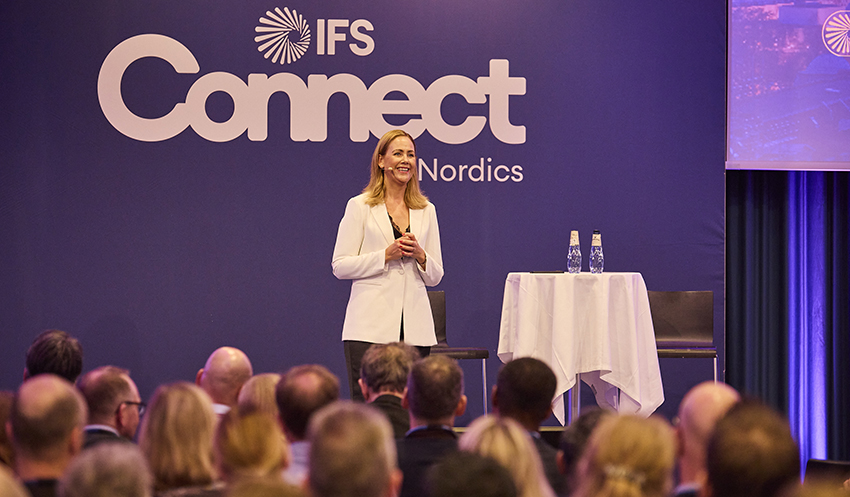“AI is undoubtedly big now,” notes Martin Gunnarsson, so big that with its apparently unlimited possibilities it has a tendency to disturb the circles in many places. The promises of technology are like a turbo on pure business logic. Used correctly, it can bring progress far beyond expectations.
“Exactly, but there is still some development work left,” says Dan Matthews. “We are now entering an ‘AI-in-practice’ mode. What is new is the generative, it has opened people’s eyes. But it is important to ask the right questions and that requires some thought. We definitely see a hockey stick effect in a process where we as an ERP supplier need to play a big role. When customers solve this themselves it has its risks. For optimization, and if something goes wrong, you want to know and understand that AI has ‘thought’ correctly. It can be achieved and we build this into our machine learning service.”
In this, IFS is prepared to take a major role in order for it to be safe, reliable and secure, he adds.

Builds on IFS’ composable architecture
When it comes to technology, IFS’ solutions are generally based on a strong modular concept. “A composable architecture,” it is usually described as. This architecture, which gives is an optimal opportunity to put together combinations with exactly the varied functionalities needed in any organization, large or small. It is about replaceable functional components that can be switched on, or off, which is almost exactly what analysts such as Gartner and CIMdata are talking about when it comes to the state-of-the-art concept of Product Innovation Platforms.
For IFS, the AI tools are within the scope of IFS.ai. This architecture provides an extended and user-defined experience for employees in all functions of the business operations. Because this can be adapted to their specific way of working, the AI approach helps them become more efficient and their organizations can automate and optimize processes across traditional operational and data silos.
IFS.ai and the structural arrangement
In general, IFS.ai runs all IFS’ functions and works natively with IFS Cloud, IFS Ultimo, IFS assyst, and IFS Poka.
“The capability is enhanced with AI and delivered to the user to create deeper and broader business value,” says Dan Matthews, and points out the overall structure of IFS.ai as follows:
The IFS.ai Data Foundation, Orchestration Layer and Co-Pilot work dynamically and integrated with IFS’ capabilities to combine data and AI to work together or separately based on the user’s role.
- The IFS.ai Data Foundation ensures the availability of real-time data, in everything from company data and customer data, to telemetry and third-party data. All in order to enable IFS.ai to provide relevant insights.
- IFS.ai Orchestration: Combines data and AI dynamically, switching components to leverage them individually or together with the data needed to execute a process. IFS.ai orchestration services are delivered based on roles and processes.
- IFS.ai’s Co-Pilot plays a significant role in continuously helping users become more efficient, more productive and deliver at a higher quality using telemetry data and other role-relevant data.
- IFS.ai Interactive Experience: Here IFS.ai uses telemetry data where the employees/users interact with IFS technology. These datasets are tailored to their different roles and to align processes and prioritize actions that create added value.
Simulation of complex industrial chains
Having said this, notably IFS AI solutions are largely characterized by an industrial apporoach and orientation, above all related to the company’s six main industrial tracks (see the introduction).
”For example, you can and should simulate what needs to be done with our AI engine. You can set up AI-based scheduled manufacturing plans, optimize with AI, operate the production line with AI, and in this detect anomalies with genAI that can be corrected with action plans,” says Matthews.
Why is the simulation bit important?
“Several reasons,” he replied explaining that, “In industrial manufacturing, this is about often complex chains where several different branches have to be coordinated and where one is linked to and affects the other. Production of batches, variant management that affects the production line, lead times towards the customer, logistics and service are just a few examples of factors included in the chains. How can this be optimized? AI-based simulation can provide good answers with a broadened application that can show what happens if the company receives an order that, for example, also involves several plants: Do we need to go up to three shifts? Should another machine be activated? What other batches due for production does the new order collide with? What is the optimal coordination of this? Etc. In this, the AI can use historical data and the simulation engine ‘itself’ tries different algorithms to drive realistic scenarios over the cloud. All together this can have important positive business effects.”
For example, you can find out what it takes to go from 95% efficiency to 99%, which in turn can create very good financial contributions through the ability to optimize the opportunities that comes with reaching new and higher effectivity levels.
”Generative AI is not cheap”
Quite complex capabilities, then, how do you get started? What does it cost? We discussed the matter with senior VP, Martin Gunnarsson.
“As can be seen from the discussion so far, AI is not simple to implement, which means that you have to think in step-by-step processes. At the same time, AI is not cheap, but implemented in the right order and in the right places, it is definitely worth while considering the huge potential where AI above all supports the people in the business processes. So, when assessing the value of investment in this, it is important to take account of a natural need for tuition money. Not all projects may produce lightning-fast results, but when progress does come, it can be a matter of giant leaps.”
Gunnarsson further points out that the investments made within IFS, with the aim of embedded AI capabilities across the entire IFS Cloud platform, above all support the company’s industrial main track.
“Yes, it is clear that this has effects on our AI system’s setup. We support our six main industrial tracks with the aerospace & defense, energy, construction & civil engineering, manufacturing, service and telecom segments. All of these manufacture, build, service, maintain, store and distribute physical products. Our AI must be put in this context, where we are now working intensively on developing use cases. It may be about the production-related bits that Dan Matthews brings up, but of course it also has as much the focus on connecting this with logical and, so to speak, natural business functionality further down the chain.”
Gunnarsson added: “It can be about payment forecasts for a customer, where you can produce forecasts based on all historical data via the AI. Everything can thus be seen in a life cycle perspective.”

Optimization with consideration
to a variety of parameters
What might such a loop look like? Martin Gunnarsson again:
* You can, for example, simulate what happens if we need to change production after a large order.
* Plan with the existing information you currently have.
* Optimize taking into account a number of parameters, e.g. taking into account delivery time, production time, stock status, configuration requirements, etc.
* Next, we get into the operational mode of operation, where things like tracking anomalies and generating activities to fix them. AI makes quick suggestions on what to do here.
* You can also imagine connecting the distribution, service and maintenance parts.
It is this type of life cycle loop that IFS’ solutions aim for, says Gunnarsson and continues: ”We are talking about the importance of the use cases and the plans over time include more than 400 scenarios that we will implement in IFS Cloud. By being what we call ‘evergreen’ – that is, on as recent a release as possible – you will get access to these.”
“This is a question of a continuous delivery dynamic where AI becomes a natural part of the business process for our customers. We currently have around 20 use cases implemented, but the number grows with each new release. The pace today is a new edition every six months.”

”The market is ripe for AI”
In summary: ”The market is ripe for AI, we have the tools you need to get started and we are well ahead of the curve in the development of new AI tools and development of use cases,” claims IFS Norden manager, Ann-Kristin Sander. ”2024 will be the year when AI is seriously established in companies.”
She also emphasizes the importance of the IFS ecosystem when AI is now to be initiated and implemented in companies.
– Just as our composable architecture is a technological key to success, and just as the cloud is as a technology platform for IFS Cloud, our partners in the ecosystem are very important. Players such as Microsoft, Accenture, Capgemini, Boomi, Pagero and others can offer comprehensive solutions where AI plays a decisive role.






